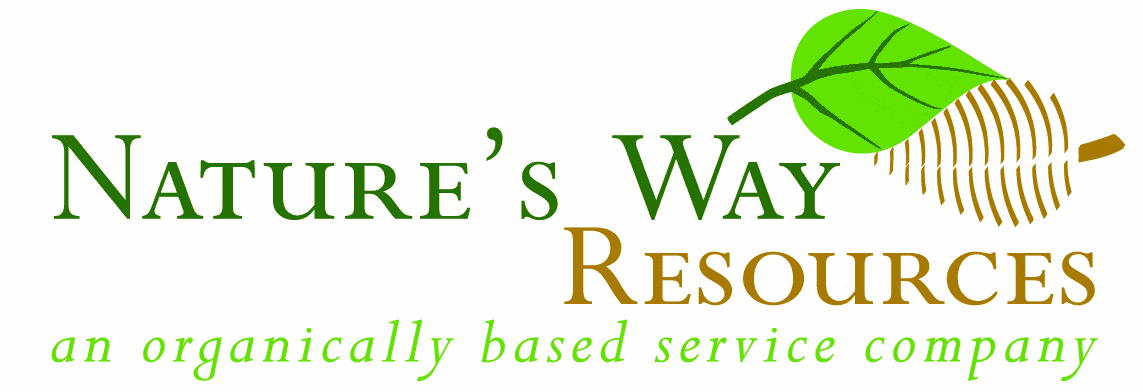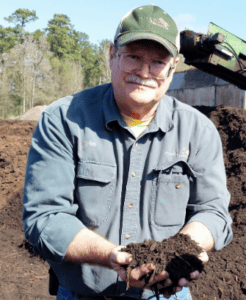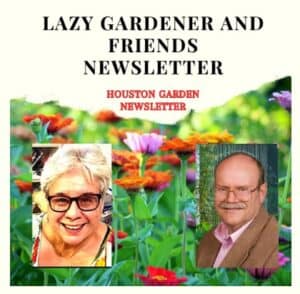 Nature’s Way Resources is proud to produce & email you this free weekly newsletter. We have no ads, but sponsors do graciously help support this project as a public service. Please note their names below & show your gratitude for this free service by patronizing their businesses! To become a sponsor, call (936) 273-1200
Nature’s Way Resources is proud to produce & email you this free weekly newsletter. We have no ads, but sponsors do graciously help support this project as a public service. Please note their names below & show your gratitude for this free service by patronizing their businesses! To become a sponsor, call (936) 273-1200
Nature’s Way Resources owner John Ferguson, “The Lazy Gardener” Brenda Beust Smith and Pablo Hernandez welcome your feedback and are so grateful to the many horticulturists who contribute their expertise
Click here to join our email list
CLICK HERE for PDFs OF PAST LG&F NEWSLETTERS
“If someone offers you advice on “Gardening in Texas,” run! They
obviously don’t understand (probably from another “smaller” state.
— Author unknown – but must know Texas!

PLUMERIA SOCIETY OF AMERICA SALE STARS (See below!)
SUMMER AIN’T COMIN’ IT’S ALREADY HERE!
Get the umbrellas out!
BY BRENDA BEUST SMITH
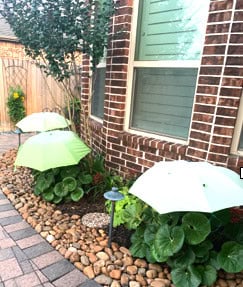 SUMMER ARRIVED HERE BACK IN MAY when we hit a record high of 97º. Predictions of triple-digit heat are more a probability than possibility — a real problem now as plants, especially new ones, haven’t had time to acclimate. DEBBIE STARNS in Richmond is ready with her stock of cute small umbrellas. Using green painter’s tape she attaches 3-4′ green garden sticks, using green painter’s tape, to umbrella poles, then attaches them to 3-4 foot green garden poles with green twisty and pushed down into soil. Debbie Starns photo
SUMMER ARRIVED HERE BACK IN MAY when we hit a record high of 97º. Predictions of triple-digit heat are more a probability than possibility — a real problem now as plants, especially new ones, haven’t had time to acclimate. DEBBIE STARNS in Richmond is ready with her stock of cute small umbrellas. Using green painter’s tape she attaches 3-4′ green garden sticks, using green painter’s tape, to umbrella poles, then attaches them to 3-4 foot green garden poles with green twisty and pushed down into soil. Debbie Starns photo
If heavy winds are a challenge, Debbie uses a 3-4′ shepherd’s hook to the green umbrella so it won’t blow away. Tip o’ trowel to Dollar Stores who, Debbie reports, have (had?) “Belle Cloches” plant covers for $1.25 each. Warning: Not sure that’s still the case, but you get the protection idea. Glad to share other good sources.
 DID YOU KNOW THE PLUMERIA SOCIETY OF AMERICA was founded here in Houston in 1979 by ELIZABETH THORNTON, NADINE BARR and (American folk singer/songwriter) NANCY AMES? Before this, it was almost impossible to purchase a plumerias (frangipani) here. Few folks had even heard of this Mexico/Central America/Caribbean native. (Hawaii had been growing them since1869s). With great publicity, plumerias caught on quickly here. By 1983, Elizabeth had over 500 blooming plumerias in her yard alone!
DID YOU KNOW THE PLUMERIA SOCIETY OF AMERICA was founded here in Houston in 1979 by ELIZABETH THORNTON, NADINE BARR and (American folk singer/songwriter) NANCY AMES? Before this, it was almost impossible to purchase a plumerias (frangipani) here. Few folks had even heard of this Mexico/Central America/Caribbean native. (Hawaii had been growing them since1869s). With great publicity, plumerias caught on quickly here. By 1983, Elizabeth had over 500 blooming plumerias in her yard alone!
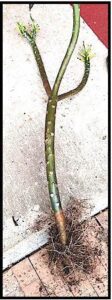 PERSONAL PLUMERIA PS.:
PERSONAL PLUMERIA PS.:
“WHAT’S THAT PLANT GROWING IN YOUR LAUNDRY ROOM?”
Friend LYNN MORALES asked me this recently. How embarrassing! Before last year’s first freeze, I jerked my 6+’ plumeria out of ground, shook soil off roots and stuck it out of sight (as usual) in a cardboard box in laundry room, ready to replanted this spring. Always greened up and bloomed. This spring, forgot to put her back out. Already sprouted new leaves! Rest assured, she’s now outside in her oversized bottom-less pot (like a cylinder) Hopefully happy now & forgiving me!!
(NOTE: Photo not mine, but looks like mine tho mine has more branches!)
Brenda Beust Smith’s column is based on her 40+ years as the
Houston Chronicle’s “Lazy Gardener” column, continuing sponsored
by Nature’s Way Resources in 2013 — (lazygardenerbrenda@gmail.com)
Brenda’s column focuses ONLY on the Greater Houston Area

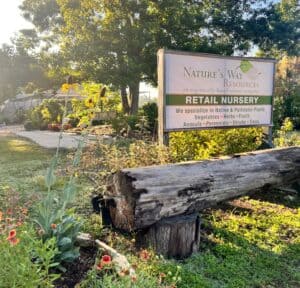 ATTN. GARDEN/PLANT GROUPS — Nature’s Way Resources offers free guided tours of NWR’s extensive nursery/soil/mulch facilities for garden clubs, plant societies and other plant-oriented, organized groups. As usual, NWR’s now-expanded meeting site is free to above groups. Reservations a must for both. Great time to visit!
ATTN. GARDEN/PLANT GROUPS — Nature’s Way Resources offers free guided tours of NWR’s extensive nursery/soil/mulch facilities for garden clubs, plant societies and other plant-oriented, organized groups. As usual, NWR’s now-expanded meeting site is free to above groups. Reservations a must for both. Great time to visit!
- SUBMITTING CALENDAR EVENTS?: For next upcoming newsletter, submit in exact format (see top of calendar below. Reformatting = delay)
Spotlighting…
Plumeria Society of America

Plumeria for Gulf Coast:
New Varieties & Smart Strategies
for Changing Conditions
By DONNA CHRISTY
PLUMERIA SOCIETY OF AMERICA
theplumeriasociety.org
In the ever-tropical microclimate of Greater Houston, plumeria isn’t just a summer bloomer—it’s a staple of the Gulf Coast garden. But even seasoned growers are navigating new territory: rising heat indexes, more erratic rainfall, and increasingly powerful storms are reshaping how we cultivate these beloved trees.
Add to that the excitement of new varieties, and it’s clear: 2025 is shaping up to be a pivotal year for plumeria enthusiasts.
What’s New on the Plumeria Front?
While many local gardeners are familiar with classics like ‘Celadine’ and ‘Lemon Drop’, this year introduces new cultivars, such as:
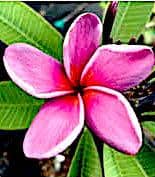 ‘CHAING MAI PRINCE’
‘CHAING MAI PRINCE’
A spectacular variety (right) with dark purple buds and 3″+ flowers of unmistakable rarity adorn this cultivar. Newly-opened flowers have a gorgeous ruby purple glow with unique, eye-catching greyish purple veining and a small tight orange eye.
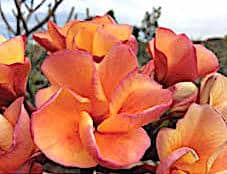 ‘ORANGE AMITY’
‘ORANGE AMITY’
This highly desirable cultivar features huge clusters of 2.5” + blooms of golden orange to red orange.The center of the bloom is a remarkable dark red orange sunburst extending outward. Petal edges are softly rippled and lined with a slight fuchsia hue
 ‘LEGACY’ This compact grower at right features unique blooms of 3”+. Random streaks of color cover the wide, overlapping, ruffled petals.
‘LEGACY’ This compact grower at right features unique blooms of 3”+. Random streaks of color cover the wide, overlapping, ruffled petals.
Look for these (and more) at sales
hosted by regional plumeria societies
and local nurseries. Availability’s limited early in the season,
so keep an eye on inventory announcements.)
John’s Corner
NEWS FROM THE WONDERFUL WORLD
OF SOIL AND PLANTS
Subject: myths about mosquito spraying weeds
In the May/June issue of American Gardener pp. 36-37, there was a nice article on the lies about mosquito spraying. We have known for years that mosquito spraying makes mosquito issues worse.
“Mosquito spraying propaganda follows a well-worn playbook of false product marketing: 1) name a target; 2) spread myths about that target; 3) invoke guilt by association about other misunderstood targets (usually ants and spiders); and 4) promise a paradisiacal existence once all targets are eliminated.”
It can take a million droplets of insecticide to kill just one mosquito. This spraying also kills all the mosquito predators which do not reproduce as fast as mosquitoes hence the problem becomes worse. The chemicals used seep into our houses and have been linked to cognitive problems, reproductive issues, and increased death from cardiovascular disease.
Now that we are well into our growing season, a common problem for gardeners is weeds. So here are a few tips to help manage weeds.
1) Prevention – this starts with ensuring one has healthy soil. One of the functions of the plants we call weeds is to correct soil problems. If you are missing essential nutrients, have soil compaction, have low organic matter, even excessive fertilization messes up soil chemistry and becomes a magnet for weeds. Nature hates bare ground hence a good mulch layer is essential.
2) Hand digging is effective for many weeds, especially when young and for some species like nut grass. Getting started early before they can become established makes it much easier. Some species like nutgrass can easily increase 5x per week, hence starting early is essential.
3) Competition and shading – it is much harder for weeds to grow if the space is already filled with other plants. These plants with established root systems will outcompete weeds for water and nutrients. Most weedy species are sun lovers, hence established plants robs the weed of energy by shading it.
4) Most plants need at least 6 parts per million oxygen in the soil or their roots die. If one over waters and the pore space is filled with water (no oxygen), Mother Nature sends in her clean-up crew to fix the problems aka weeds.
5) Most plants require lots of fungus in the soil. When we till our soil, we destroy (kill) the good fungi leaving only the bacteria to grow and multiply which quickly dominates the soil. The weedy species of plants love bacterial dominated soil. Hence one has selected weeds over other plants that need fungi. Note: when planting seeds or transplants the least we disturb the soil the better.
6) Weed control – if one has a large area a technique known as solarization can be an effective tool. This involves covering the area with a plastic sheet, depending on the environment black or clear plastic might work better. I prefer clear plastic as more of the sun’s energy goes through and heats up the soil eventually cooking the plants. One can look through clear plastic and see when the plants have all died and the area is ready for use.
I have used newspaper or cardboard on multiple occasions to kill weeds or remove undesired plants. Cover the area with a layer of newspaper at least five pages thick, overlap the paper by one third, wet it down and cover with mulch. The weight of the water and mulch presses the paper down against the ground blocking sunlight and airflow. By the time the paper rots the plant material underneath is dead and the area is ready to use.
If using cardboard, one layer of cardboard is usually sufficient if it is overlapped so no shoots can work their way through.
I prefer this method as the dead plant material, decomposed paper and mulch also enrich the soil to help establish the new plants.
7) One of my favorite tools is a flame weeder that uses a one-pound propane cylinder on a long-handled torch. Most have an electric start hence very easy to ignite. Just 1-2 seconds kills most weeds. It was great for controlling weeds on our brick patio and on the expansion joints of our driveway and sidewalks.
8) Another tool is agricultural vinegar as it is much stronger than cooking vinegar. Just spray the plant as with any other herbicide and it kills it. Vinegar will kill the top growth of all plants, hence be careful to not get it on desired plants.
I have read about folks using Everclear, gin or vodka mixed with some dish soap as a surfactant. They mix a couple ounces of the alcohol beverage into 2-3 cups of water and add a few drops of liquid soap and then spray the plants. I have never tried this method.
A few people like to use boiling water and pore over the weeds growing on concrete expansion joints.
9) The Woodlands Water newsletter has an nice article this week also on weeds:
6 great tips for growing weeds
Don’t skimp on the synthetic fertilizer
Use cheap, non-organic fertilizer to reduce oxygen levels and beneficial organisms – great for weeds, bad for plants and turf grass.
Apply a full spectrum fungicide
Your weeds will love the bacteria that fungicides stimulate.
Water A LOT
Irrigate more than an inch a week to fill pore spaces in the soil and create an inviting anaerobic environment your weeds will enjoy.
Save a few bucks with industrial mulch
Go for cheap mulch that has a high carbon-nitrogen ratio – a boon for weeds while doing a great job of weakening your plants.
Use Round-Up
But the commercial says weeds hate Round-Up? They do, but just in the short-term. Glyphosate-based herbicides actually promote long-term weed growth by increasing bacteria levels in the soil (remember, weeds love bacteria).
Lean on landscape fabric
Apply fabric to collect organic matter on top of it and create a comfy bed for weed seeds to thrive. And when the fabric eventually disintegrates weed roots will move right in.
SPONSORSHIP
If you are interested in becoming a sponsor, please contact us at 936-273-1200 or send an e-mail to: lazygardenerandfriends@gmail.com
ABOUT US
BRENDA BEUST SMITH
WE KNOW HER BEST AS THE LAZY GARDENER . . .
but Brenda Beust Smith is also:
- a national award-winning writer & editor
- a nationally-published writer & photographer
- a national horticultural speaker
- a former Houston Chronicle reporter
When the Chronicle discontinued Brenda’s 45-year-old Lazy Gardener” print column — started in the early ’70s as a fun side-project to reporting, it then ranked as the longestrunning, continuously-published local newspaper column in the Greater Houston area. The name, she says, is not just fun, it’s true.
Brenda’s gradual sideways step from reporter into gardening writing led first to an 18-year series of when-to-do-what Lazy Gardener Calendars, then to her Lazy Gardener’s Guide book which morphed into her Lazy Gardener’s Guide on CD, which she now emails free upon request.
Brenda became a Harris County Master Gardener and, over the years, served on theboards of many Greater Houston area horticulture organizations. She hosted local radio and TV shows, most notably a 10+-year Lazy Gardener specialty shows on HoustonPBS (Ch. 8) and her call-in “EcoGardening” show on KPFT-FM.
For over three decades, Brenda served as Assistant Production Manager of the GARDEN CLUB OF AMERICA’S “BULLETIN” magazine. Although still an active broad-based freelance writer, Brenda’s main focus now is THE LAZY GARDENER & FRIENDS HOUSTON GARDEN NEWSLETTER with John Ferguson and Pablo Hernandez of Nature’s Way Resources.
A native of New Orleans and graduate of St. Agnes Academy and the University of Houston, Brenda lives in Humble, TX, and is married to the retired Aldine High School Coach Bill Smith. They have one son, Blake.
Regarding this newsletter, Brenda is the lead writer, originator of it and the daily inspiration for it. We so appreciate the way she has made gardening such a fun way to celebrate life together for such a long time.
About her column, Brenda says: “I don’t consider myself a ‘garden writer.” I started out 50+ years ago as a very lazy “gardening reporter.” I still feel that way today. I hope my columns inspire/help newcomers, but I do not write to them. I write to very experienced gardeners who want to expand their horizons.
JOHN FERGUSON
John is a native Houstonian and has over 35 years of business experience. He owns Nature’s Way Resources, a composting company that specializes in high quality compost, mulch, and soil mixes. He holds a MS degree in Physics and Geology and is a licensed Soil Scientist in Texas.
John has won many awards in horticulture and environmental issues. For years he represented the composting industry on the Houston-Galveston Area Council for solid waste. His personal garden has been featured in several horticultural books and “Better Homes and Gardens” magazine. His business has been recognized in the Wall Street Journal for the quality and value of their products. He is a member of the Physics Honor Society and many other professional societies. John is the co-author of the book Organic Management for the Professional.
For this newsletter, John contributes articles regularly and is responsible for publishing it.
PABLO HERNANDEZ Pablo Hernandez is the special projects coordinator for Nature’s Way Resources. His realm of responsibilities include: serving as a webmaster, IT support, technical problem solving/troubleshooting, metrics management and quality control. Pablo helps this newsletter happen from a technical support standpoint.
Download the Newsletter with Our Events Calendar Below!
